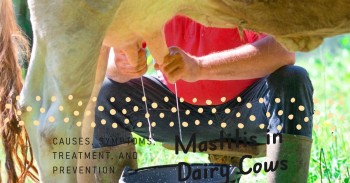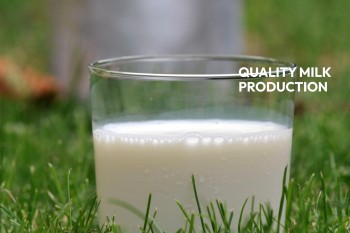🐮🥛 Nutrition Tips for Healthy Dairy Cattle 🐄🥛🐮
As a veterinary professional, proper nutrition is crucial for raising healthy and productive dairy cows. Here are my top nutrition tips for optimal dairy cattle health and milk production:
👉 Feed a Balanced Ration
Cows need a balanced diet with all the essential nutrients. Their rations should contain adequate amounts of energy, protein, minerals, vitamins and fiber. Energy comes from carbohydrates and fats while protein comes from sources like soybean meal. Minerals like calcium, phosphorus, magnesium, potassium, sodium and chloride are critical for bone health and bodily functions. Vitamins like A, D, E and B-complex aid metabolism and immunity. And sufficient fiber from roughages keeps the rumen functioning properly.
When formulating rations, nutritional requirements depend on factors like age, breed, body condition, stage of production and environment. Working with a qualified dairy nutritionist is the best way to develop customized feeding programs for specific groups of cattle. Rations can then be adjusted as needed based on dry matter intake, milk production, weight gain, health status and feed analysis.
👉 Provide Free Access to Clean Water
Water is the cheapest yet most crucial nutrient for dairy cows. They need free access to plentiful, fresh and clean water at all times. Water supports digestion, milk production, metabolism, temperature regulation and waste removal. Cows drink 30-50 gallons of water per day!
Ensure water troughs are kept clean. Check that water flow rate is adequate, especially during hot weather. Clean troughs regularly to avoid algae buildup. In winter, use tank heaters to prevent freezing. Routinely test water quality - high levels of minerals, bacteria or toxins can impact cow health and milk quality. Proper water access and quality helps optimize feed intake and productivity.
👉 Feed High Quality Forages
The foundation of good dairy nutrition is high quality forage like hay, silage, haylage and pasture grasses. Forages provide fiber that keeps the rumen healthy. They also supply key nutrients. Legume forages like alfalfa are higher in protein while grasses like timothy are higher in energy.
Harvest forages at the optimal stage. Make and store them properly to retain nutrient values. Send samples for regular testing to balance rations accordingly. Keep an eye on forage dry matter intake - low intakes can indicate issues with palatability or digestibility. Provide long-stem forage and adequate bunk space for cows to ruminate properly. Top quality forages support better rumen health, higher milk production and greater profits.
👉 Supplement Micronutrients
Micronutrients like vitamins and minerals are needed in smaller amounts but are just as vital for dairy cattle health and performance. Common deficiencies include magnesium, selenium, copper, zinc, manganese, cobalt and vitamins A, D and E.
Symptoms of deficiency include poor growth, infertility, weak immunity, metabolic disorders and reduced milk yield. Minerals like selenium are low in soils in many regions. Stress, disease and high milk production increase micronutrient needs. Routine blood tests help diagnose deficiencies.
Work with your nutritionist to supplement micronutrients like:
Selenium yeast
Copper sulfate
Zinc oxide
Magnesium oxide
Manganese sulfate
Cobalt carbonate
Vitamins A, D and E
Topdressing, free choice minerals or total mixed rations can be used to provide micronutrients. This helps prevent deficiencies for optimal cow health and performance.
👉 Manage Feeding Transitions
Changes in diet and feeding programs are high risk times for rumen upsets in cows. Make transitions gradually over 2-3 weeks when:
Switching from dry cow ration to lactation ration after calving
Changing from milk to solid feed for calves
Moving cows from pasture to winter ration
Introducing new feeds
Monitor intakes and rumination activity closely. Avoid sudden forage changes. Mix increasing amounts of the new feed with the old one. Feed more frequently or use buffers. Check dung consistency to spot rumen issues. Work closely with your nutritionist when making feeding transitions to prevent acidosis, bloat and displaced abomasum.
👉 Assess Body Condition Scores
Visually assessing cow body condition scores (BCS) every few months is simple but powerful nutrition management. Use the 1-5 scale to evaluate fat cover and muscling over the hips, spine, pins and tail head.
Aim for a BCS of 3-3.5 at calving for best production and health. Thin cows are weak, infertile and prone to diseases. Over-conditioned cows have calving issues and metabolic disorders. Adjust rations to achieve target BCS - increasing feed for thin cows, decreasing for over-conditioned ones.
👉 Test Forages and Rations
Lab analysis provides the nutritional breakdown of forages, feeds and total rations. This information is key for accurate diet formulation. Test new haylots, silages and other feeds regularly for contents like:
Dry matter
Crude protein
Fiber
Net energy
Minerals
Also test total mixed rations to compare against formulated values. Make ration adjustments based on results to optimize nutrient intake. This helps balance rations, prevent deficiencies and boost milk yields cost-effectively.
👉 Provide Fresh Feed
Cows are creatures of habit and prefer fresh, palatable feeds. Stale, moldy or fermented feed reduces intake, hurting productivity.
Discard spoiled feed and keep mangers clean
Store feeds properly to avoid moisture accumulation
Offer fresh feed frequently in clean bunks
Avoid heating and freezing of feeds
Ensure diet changes are gradual
Providing fresh rations encourages higher intakes for greater milk production. It also prevents sorting, acidosis and other dietary issues.
👉 Group Cows by Nutrient Needs
Cow nutrient needs differ by age, weight, breed, pregnancy status and milk production level. Grouping cows by nutrient requirements allows tailored feeding programs:
Dry cows - Rations with >1.25% calcium to support fetal bone growth
Transition cows - Gradually transitioned from dry cow to lactation ration over 2-3 weeks pre-calving
Fresh cows - High energy rations for peak milk yield
High producers - More energy and protein dense feed
Low producers - Lower protein and energy rations to prevent over-conditioning
Heifers - Rations formulated for lean growth
This strategic feeding optimizes nutrition intake and productivity for each group of cows. It also makes supplementation and ration changes easier compared to a one-size-fits-all approach.
👉 Work with a Professional Nutritionist
Dairy cow nutrition can get quite technical with the need to balance so many nutrients. Collaborating with a professional animal nutritionist is crucial for developing science-based feeding programs for optimal cow health and profits.
A good dairy nutritionist will:
Formulate rations matched to cow nutrient requirements
Adjust rations based on actual feed analysis
Suggest energy/protein/mineral supplements as needed
Recommend feeding techniques to boost intake
Help with feed transitions and diet changes
Provide technical expertise on nutrition issues
Investing in professional nutrition services pays dividends through healthier, more productive cows. It takes the guesswork out of feeding for the best returns on feed.
👉 Avoid Abrupt Ration Changes
Cows do not take well to abrupt switches in diet. Their rumen microbes need time to adapt to ration changes. Immediate major adjustments can cause rumen acidosis, off-feed events, diarrhea and even death.
When making ration changes:
Gradually transition over 2-3 weeks
Slowly increase inclusion rates of new feeds
Watch for refusals or erratic intakes
Temporarily feed more frequently or use buffers
Work closely with your nutritionist
By easing cows through diet changes, you avoid digestive upsets that hurt productivity. This allows their rumen microflora to adjust, ensuring smooth nutrition transitions.
👉 Careful Management around Calving
The transition period around calving needs careful nutrition management:
Pre-calving:
Transition to a higher energy, lower fiber ration over 2-3 weeks
Increase meal frequency from 2x to 3x per day
Ensure adequate, but not excessive, vitamin and mineral fortification
Monitor for off-feed events indicating acidosis
Calving:
Provide fresh feed and clean water in the maternity pen
Feed high-quality colostrum within 1-2 hours of birth
Post-calving:
Gradually increase ration volume and energy density
Add buffers temporarily if rumen acidosis is suspected
Assess calving ease and calf vigor to adjust future transition rations
Close nutrition management in late pregnancy and early lactation sets cows up for a healthy, productive lactation. Work closely with your nutritionist to fine-tune programs around this critical time.
👉 Handle Heat Stress Nutrition
Hot weather decreases cow appetite while increasing cooling and hydration needs. Heat stress can slash intakes, milk yield and fertility. Some tips to minimize effects:
Increase feeding frequency to stimulate intake
Offer fresh, cool feeds mixed with water
Provide extra salts, minerals and electrolytes
Install misters and fans to cool cows
Ensure adequate water flow rates or access to ponds
Formulate rations for higher nutrient density
Work with your nutritionist to adjust diets if needed
By proactively addressing nutrition issues, the effects of heat stress on cow productivity and health can be minimized.
👉 Evaluate Nutrient Levels in Milk
Nutrient levels in milk provide insight into a cow’s metabolic health and diet adequacy. For instance:
Low protein suggests deficient rumen fermentation
Low fat indicates negative energy balance
Low lactose points to acidosis risk or laminitis
High somatic cell counts indicate mastitis issues
Monitoring bulk tank milk is useful, while individual cow sampling is more precise. Work with your herd manager and nutritionist to adjust rations based on milk nutrient data. This fine-tunes diet adequacy throughout lactation for optimum production.
Summary
Proper dairy cow nutrition is complex, but fundamentally important for productivity and farm profits. Work closely with a professional nutritionist to formulate balanced rations matched to group requirements. Monitor body condition, milk nutrients and intakes to optimize diets over the lactation cycle. Provide a steady supply of fresh, palatable feeds in clean bunks. Manage feeding transitions carefully. Address seasonal challenges like heat stress. With sound nutrition programs in place, your herd will produce to its full genetic potential!
And those are my top tips for optimizing dairy cattle nutrition and health! Let me know if you have any other questions. I'm always happy to help dairy producers maximize the nutrition and performance of their herds. Here's to healthy, productive cows and successful dairy farming! 🐄🥛


















